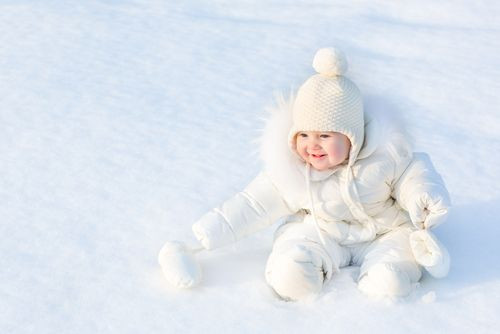The Four Seasons And Motor Development: Winter Babies Get Head Start Crawling Due To More Daylight

Seasonal birth patterns in the U.S. have predicted the top season for births as the summer, with August and September being the month the most babies are born in. While the cold, winter months help heat things up in between the sheets indoors, the arrival of newborns in the sweltering, late-summer months may leave your child at a disadvantage when it comes to motor development. According to a recent study published in the Journal of Reproductive and Infant Psychology, babies born in the winter (between December and May) start crawling earlier compared to babies born in the summer (June-November), because there is more daylight for them to be active at seven months.
Seasons and weather conditions are not only believed to play a role in the behavior of adults, but they can also influence a baby’s brain development and their handedness. The University of Vienna study found baby boys born in winter are more likely to be left-handed than those born in the summer. It is believed that an embryo’s exposure to higher levels of the male hormone testosterone in the womb increases the likelihood of being left-handed. It is believed more daylight may increase testosterone levels, and since babies are in the embryonic stage during the spring and summer, they could be more exposed to testosterone.
To further explore the seasonal effect on babies’ motor development, in particular, crawling, Dr. Osnat Atun-Einy, lead author of the study, part of the University of Haifa’s Department of Physical Therapy, and his colleagues observed 47 healthy infants with typical development patterns in a home environment between summer and winter in Israel. The researchers divided the 47 babies in two groups: 16 “summer babies,” born between June and November, and 31 “winter babies,” born between December and May.
The Alberta Infant Motor Scale (AIMS), an observational assessment guide with high reliability, was used to track the motor development of the newborns in four stages: prone (stomach), supine (back), sitting, and standing. At 7 months old, the researchers observed the babies’ motor development in their homes and conducted follow-up sessions when they began to crawl. The parents also recorded their development stages before and between the two observations.
The findings revealed the average age at which the babies started crawling was 31 weeks. However, the babies born in the winter — who started to crawl in the summer — crawled at an average of 30 weeks, than those born in the summer who began at an average age of 35 weeks. There were no differences between boys or girls, or the style of crawling.
Overall, winter babies had a higher AIMS score and also scored high for movement in the prone position, which is significant in its connection with crawling. There was no difference in the scores for the supine position, sitting, or standing between the two groups. The researchers believe the findings support the link between seasons and crawling.
The seasonal effect is prevalent in places where there are notable differences in the home environment between summer and winter. In Israel, the winter is relatively mild, whereas it is wetter and colder in the summer. The difference in crawling onset of four weeks constitutes 14 percent of a 7-month-old's life and is significant," the researchers note, according to the University of Haifa news release. "Documenting the trend by comparing the results of a standard evaluation scale strengthens the findings and points to a significant seasonal effect in the Israeli context.”
Although it remains unclear why this change occurs in the womb — possibly influenced by parent stress and vitamin D levels, or after birth — the findings do show there is an association between the change in seasons and infant growth. The researchers do acknowledge the season influences the babies’ experiences in a number of ways, including layers of clothing, time given for babies to spend on the floor on their stomachs, and the hours of activity and sunlight.
According to Baby Center, most babies learn to crawl between the ages of 7 and 10 months. This usually begins when the baby is able to sit well without support and can hold their head up to look around, while being supported by their arm, leg, and back muscles. This is typically followed by “cross-crawling,” which is moving one arm, and the opposite leg together when they move forward, instead of using an arm, and a leg from the same side.
“Awareness of the seasonal effect is important so that parents will give their babies proper movement and development opportunities in the winter as well,” said Atun-Einy, The Times Of Israel reported.
Sources: Atun-Einy O, Cohen D, Samuel M, Scher A. Season of birth, crawling onset, and motor development in 7-month-old infants. Journal of Reproductive and Infant Psychology. 2013.
Stieger S, Tran US, Voracek M. Latent variable analysis indicates that seasonal anisotropy accounts for the higher prevalence of left-handedness in men. Cortex. 2014.
Published by Medicaldaily.com



























